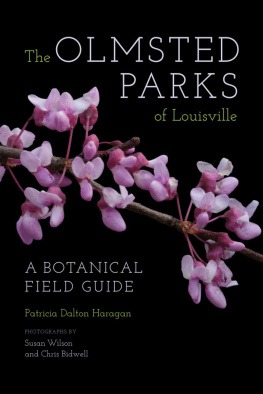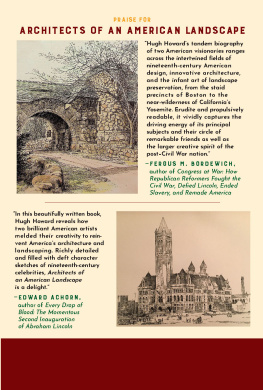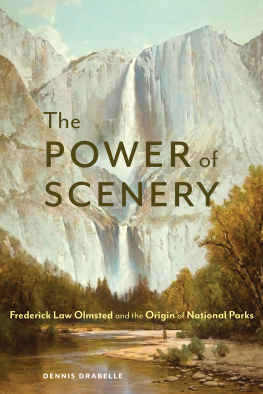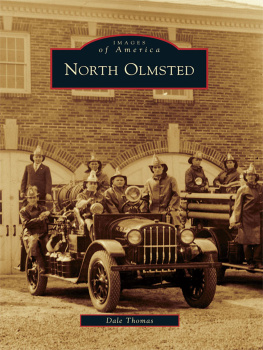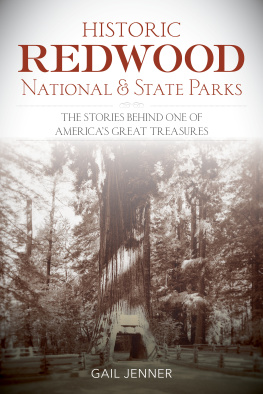The
OLMSTED PARKS
of Louisville
The OLMSTED
PARKS
of Louisville
A BOTANICAL FIELD GUIDE
Patricia Dalton Haragan
Photographs by
Susan Wilson and Chris Bidwell

Due to variations in the technical specifications of different electronic reading devices, some elements of this ebook may not appear as they do in the print edition. Readers are encouraged to experiment with user settings for optimum results.
The financial support of the Kentucky Society of Natural History is gratefully acknowledged.
Copyright 2014 by The University Press of Kentucky
Scholarly publisher for the Commonwealth, serving Bellarmine University, Berea College, Centre College of Kentucky, Eastern Kentucky University, The Filson Historical Society, Georgetown College, Kentucky Historical Society, Kentucky State University, Morehead State University, Murray State University, Northern Kentucky University, Transylvania University, University of Kentucky, University of Louisville, and Western Kentucky University.
All rights reserved.
Editorial and Sales Offices: The University Press of Kentucky 663 South Limestone Street, Lexington, Kentucky 40508-4008 www.kentuckypress.com
Library of Congress Cataloging-in-Publication Data
Haragan, Patricia Dalton, 1953
The Olmsted parks of Louisville : a botanical field guide / Patricia Dalton Haragan ; photographs by Susan Wilson and Chris Bidwell.
pages cm
Includes bibliographical references and index.
ISBN 978-0-8131-4454-2 (pbk. : alk. paper) ISBN 978-0-8131-4456-6 (pdf)
ISBN 978-0-8131-4455-9 (epub) 1. PlantsKentuckyLouisvilleIdentification.
2. PlantsKentuckyLouisvillePictorial works. 3. ParksKentuckyLouisville.
I. Title.
QK162.H37 2014
581.09769'44dc23
2013039723
This book is printed on acid-free paper meeting the requirements of the American National Standard for Permanence in Paper for Printed Library Materials.

Manufactured in Canada

To my daughters, Molly and Anna,
a privilege and joy.
With love.
In loving memory of our dear
friend Vincent Nold, our
brother and sunshine.
Contents
Arranged by Flower Color, Season, and Alphabetically by Family within Season
Spring: February, March, April
Summer: May, June, July
Fall: August, September, October
Arranged by
Evergreen: Needlelike or Scalelike
Deciduous: Leaves Alternate or Opposite, Simple or Compound, and Alphabetically by Family within Group
Foreword
Reading a Place
Stories fill our landscapesfrom the densest urban core to the wilds of Montana but finding and reading those stories requires time and some acquaintance with the special places of a site and its inhabitants. In this regard, a park is no different from Paris: to know it, you must spend time there. And the magic of Louisvilles Olmsted Parks is that they are gateways to some remarkable places, located just a few minutes down the road from every neighborhood in the city. A glance at a Louisville map shows immediately the genius of the design: from Shawnee and Chickasaw Parks in the floodplain of the Ohio River, to Iroquois in the knobs south of town, to Seneca and Cherokee in the eastern limestone uplands, the system reflects the geographic and natural diversity of Louisville.
To unravel the stories hidden in these landscapes requires knowledge, and this is where Pat Haragans The Olmsted Parks of Louisville: A Botanical Field Guide becomes your essential companion. Reading a place, as reading a book, demands a vocabulary, and a good field guide is like a good dictionary: learn the plants and you will learn to read the place, as each species occupies a niche shaped by geology, soils, past disturbance, and interrelations with other species. If you carry this guide with you and slowly master the language, new perspectives open. The uniqueness of the temperate deciduous forest of eastern North America with its oaks, migrating songbirds, and spring wildflowers contrasts sharply with the prairies to our west, the boreal forests to our north, and the subtropics to our south. As you learn the lexicon of plants, dialects emerge: the chestnut oaks of the Iroquois hills are distinct from the chinkapin oaks of Cherokee Park or the cottonwoods of the Shawnee floodplain, and there are reasons for this rooted in the soils, rocks, hydrology, and human history. New conversations become possible: the past uses of plants by Native Americans, a plants edible characteristics, their relations with distant cousins in the tropics or the arctic.
This is how we come to know place, and how we give identity to that distinctive Kentucky landscape that is essential to our city, and to ourselves. Our rolling limestone hills, their amazing fossils, spring colors, and the diverse wildlife that in turn feeds on those plants, encompass our natural history. While a field guide begins as a dictionary, it becomes a tour book, introducing a world of stories that is limited only by your willingness to spend time unraveling them. Somewhere in that journey, the deeper magic of our parks will reveal itself. Without such a guide, city dwellers will never come to know nature or develop a deeper understanding of place, and that is a loss. Build them and love them, and suddenly you connect to the ancient world and rhythms that linger behind our buildings and beneath our pavements. The twenty-first century will be an urban century, and the ability to make those connections is no small thing, and books like this will guide those urban billions back to nature.
DANIEL H. JONES
Chairman and CEO, 21st Century Parks, Inc.

Introduction
SUSAN M. RADEMACHER
Parks Curator, Pittsburgh Parks Conservancy
Founding Executive Director, Louisville Olmsted Parks Conservancy
Who was Frederick Law Olmsted? And what is special about his Louisville parks as containers for such a stunning array of native and naturalized plants?
This towering shaper of the American landscape explored many roles seaman, farmer, mine manager, abolitionist, Federal Department of Sanitation Commissioner, writer, and publisheron his journey to becoming the nations first landscape architect. As befits a pioneer, Olmsted was obstinate and strong willed, true to his convictions. He was labeled long-headed for his obsession with planning and his ability to project his ideas for generations into the future.
At age twenty-eight, on a life-changing tour of England, Olmsted was thrilled to experience a landscape designed as a work of art. His response upon visiting Capability Browns Eaton Hall was to write: What artist, so noble, has often been my thought, as he, who with far-reaching conception of beauty and designing power, sketches the outline, writes the colours, and directs the shadows of a picture so great that Nature shall be employed upon it for generations, before the work he has arranged for her shall realize his intentions?
Olmsted well understood that his work was a pact with nature. The core tenets of his philosophy were these:

